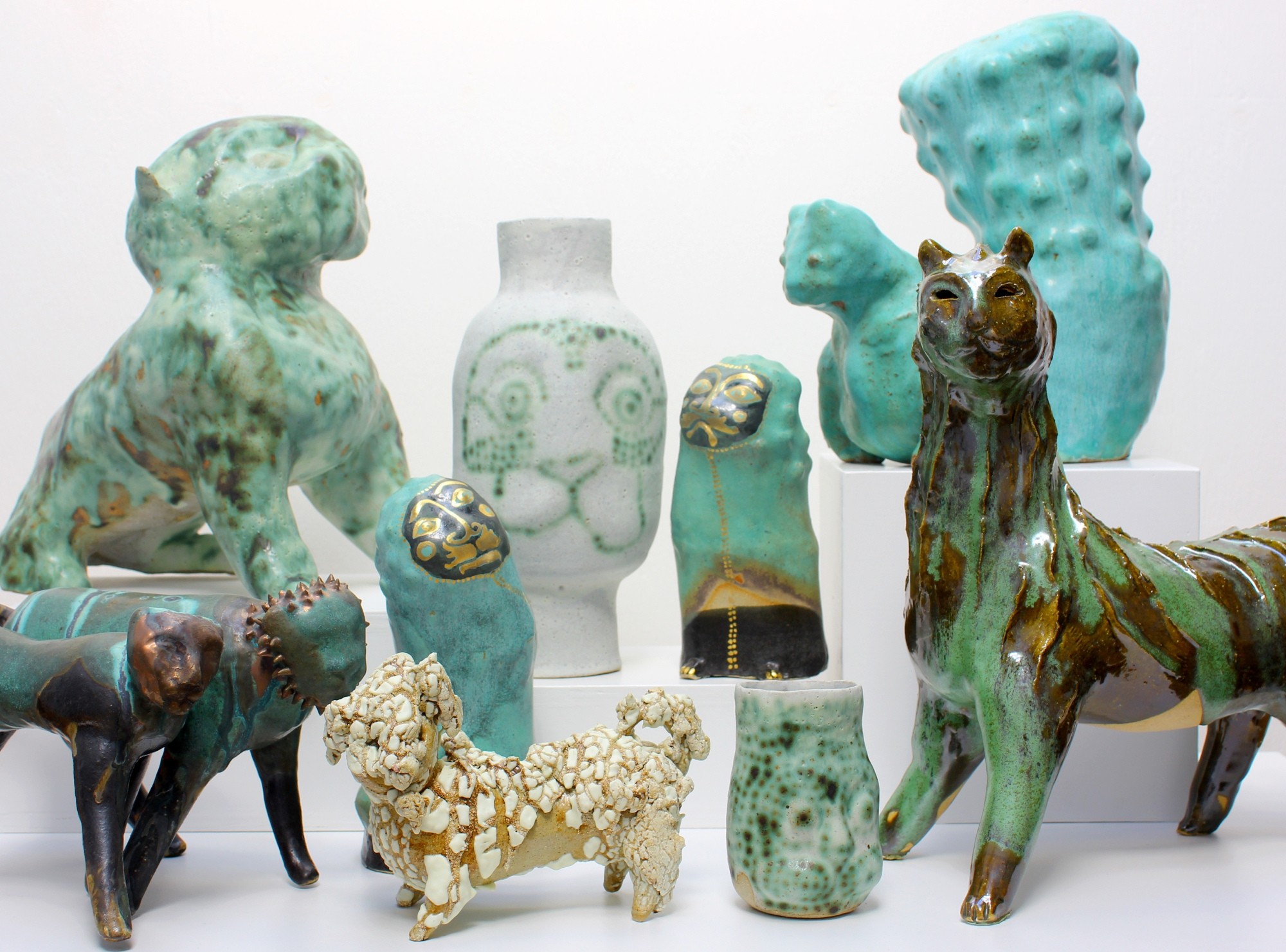By Lilianne Milgrom
Australia’s cities are vibrant and modern, and the country’s overwhelmingly urban population is diverse and hip. Yet this antipodal island’s geographic remoteness feels almost palpable – hence its nickname, The Land Down Under. Its vast, largely uninhabited interior feels omnipresent, host to a unique ecosystem that has forged a distinctive Australian spirit highly attuned to the natural environment and the inherent threats posed by climate change. These sensibilities were evident in the work of the four ceramicists whose exhibitions I had the pleasure of viewing during my brief stay in Melbourne.
Collectively, their works shared a cerebral, intentional purpose. Individually, each artist explored a different facet of the complex relationship between maker and his or her environment. To stay engaged with the climate emergency ‘without getting stuck in despair or outrage’ Canadian-born artist Claire Ellis aims to make a political impact by creating work that arouses the viewer’s curiosity.
The vessels in her Craft Victoria exhibition Triple Cooked take on the fossil fuel crisis by mimicking the scarred earth resulting from Australia’s robust mining industry. The three sentinel vessels are coil-built from clay made of reclaimed landscaping basalt which Ellis sources from quarry off-cuts and stonemasons. The same rock is broken into pieces, tumbled, and then fitted into hand-molded crevices that pockmark the surface of each vessel. Surprisingly, these bold, tactile vessels are fired in a single firing.
While working as a chef at a critically acclaimed restaurant in Melbourne, Ellis began transitioning from what went on the plate to the plate itself, creating tableware for the tasting menu in a makeshift ceramic studio within the restaurant. This shift was prompted by a need to step away from the stresses of working in the high-octane food industry. Ceramics allowed her “to slow down while still being creative and working with my hands.” In clay, she has not only found catharsis, but an outlet for her environmental activism where her experience in the kitchen has held her in good stead. “My chef experience has taught me that things take a lot of tweaking and quite a few tries before they are just right.”
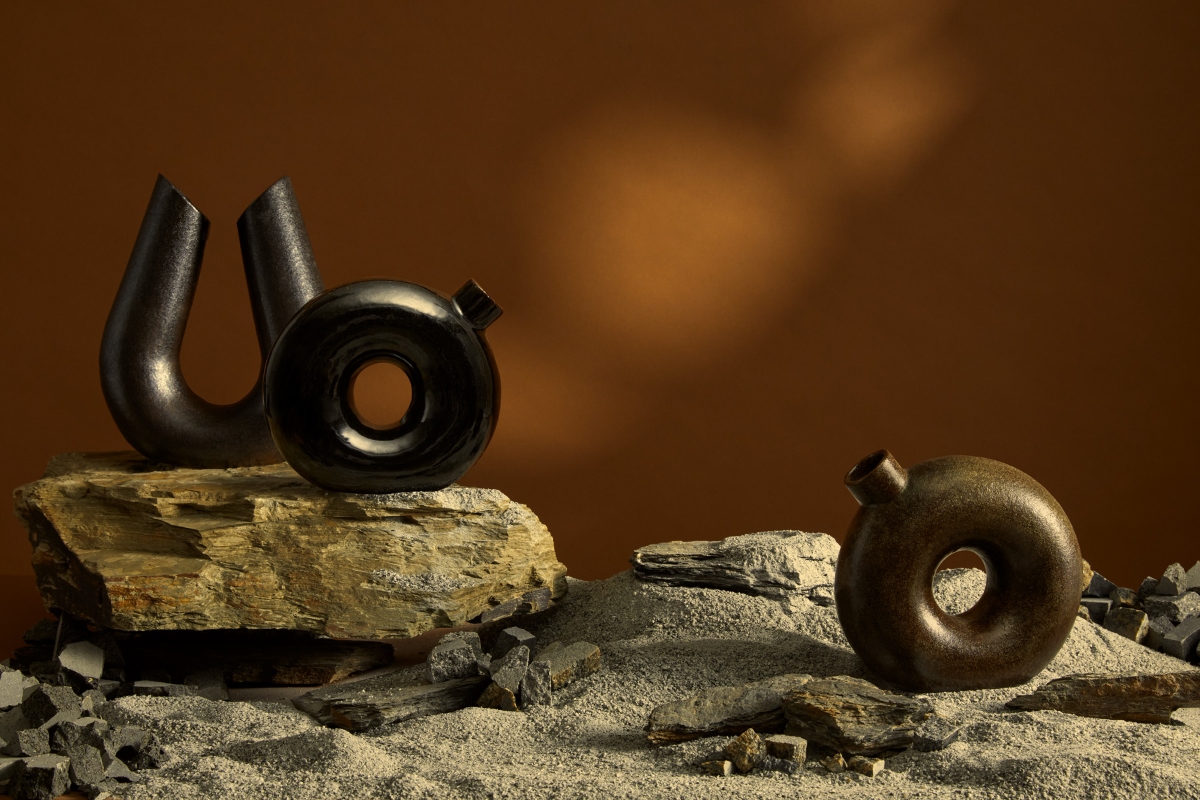
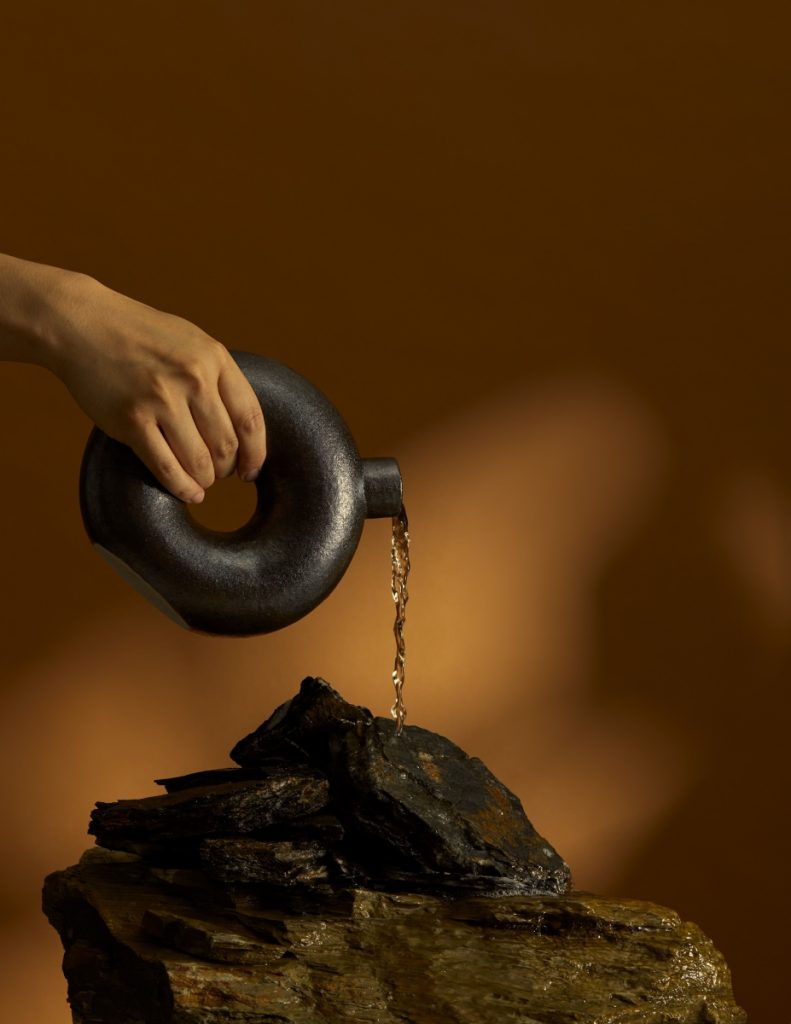
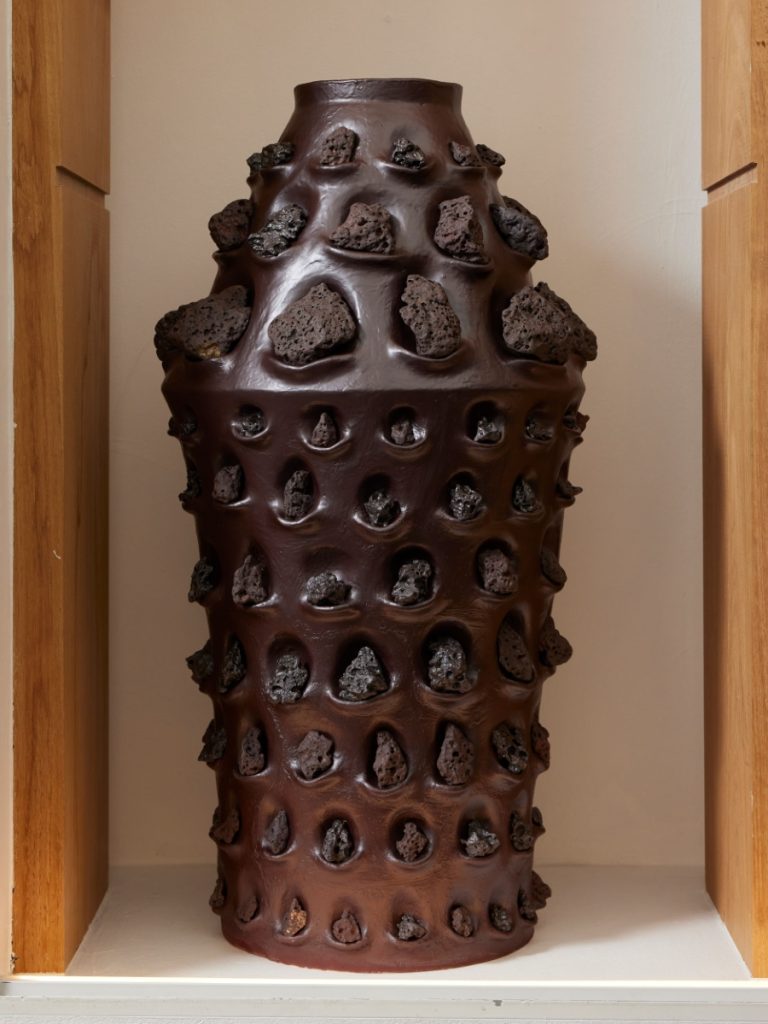
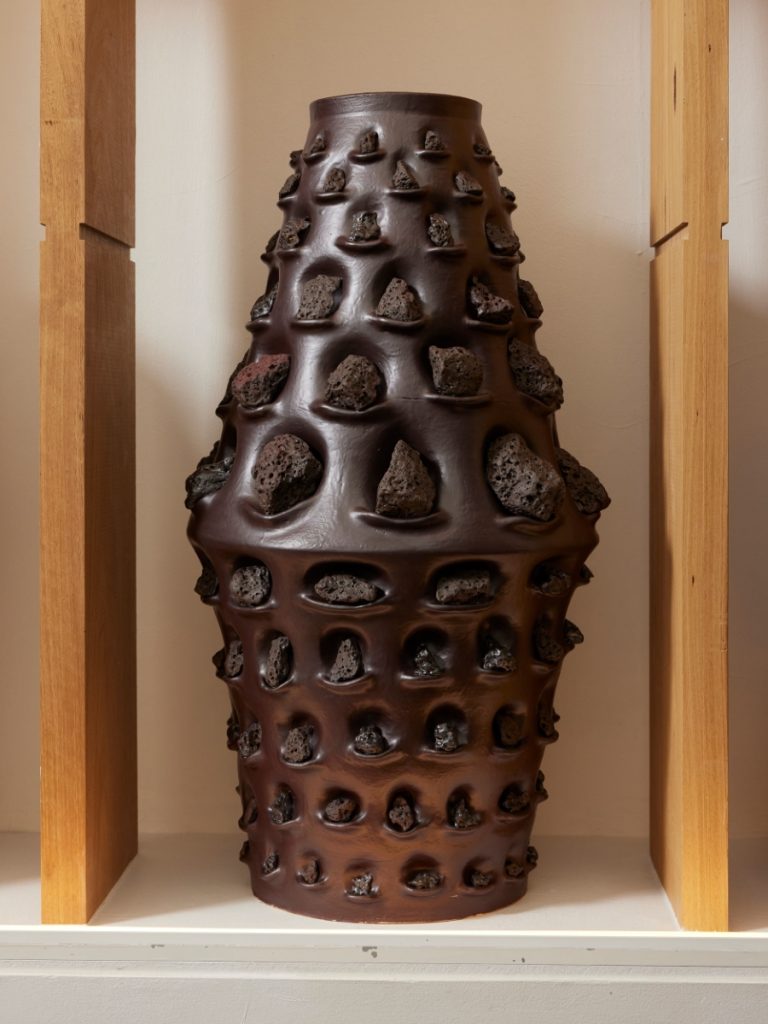
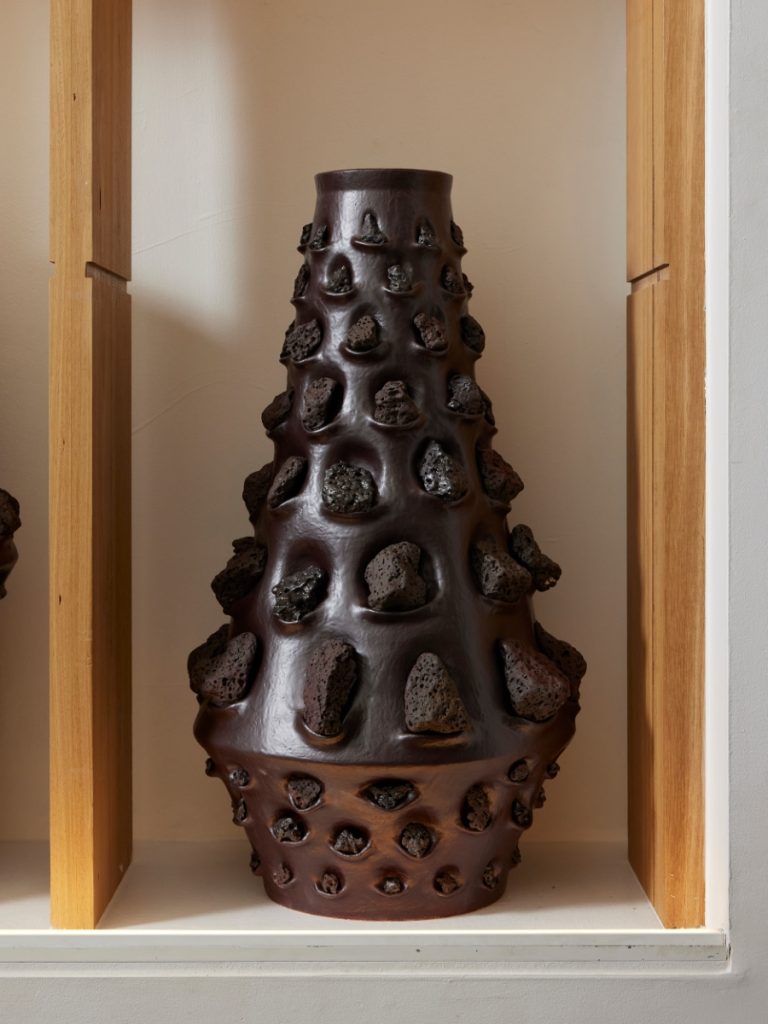
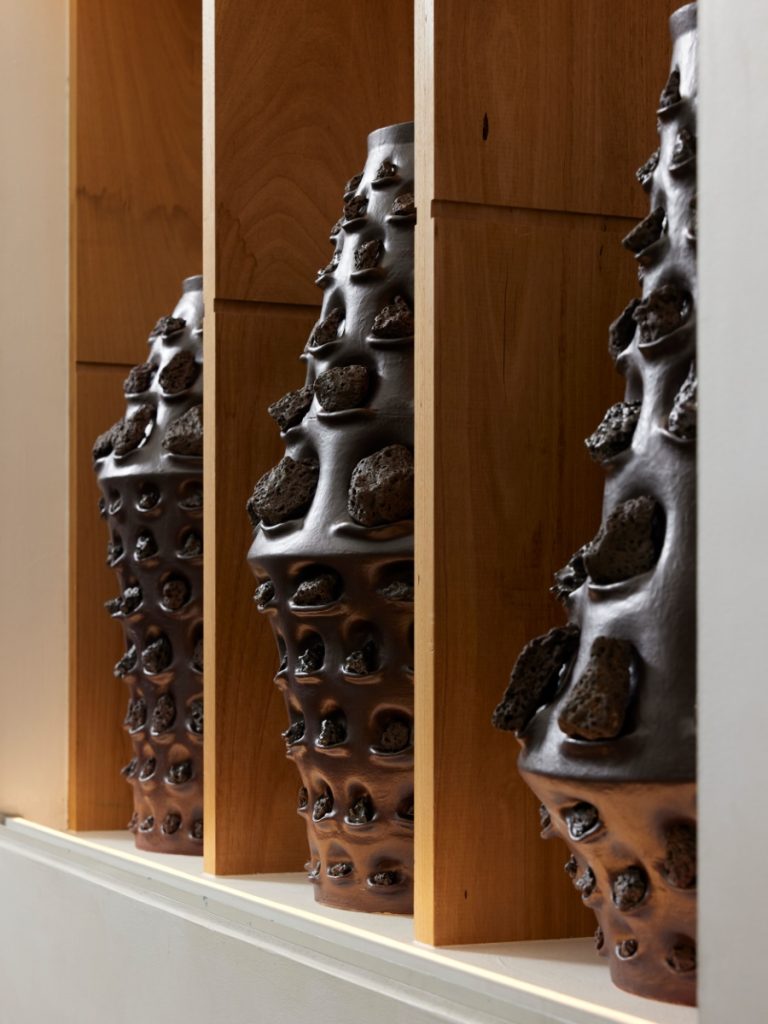
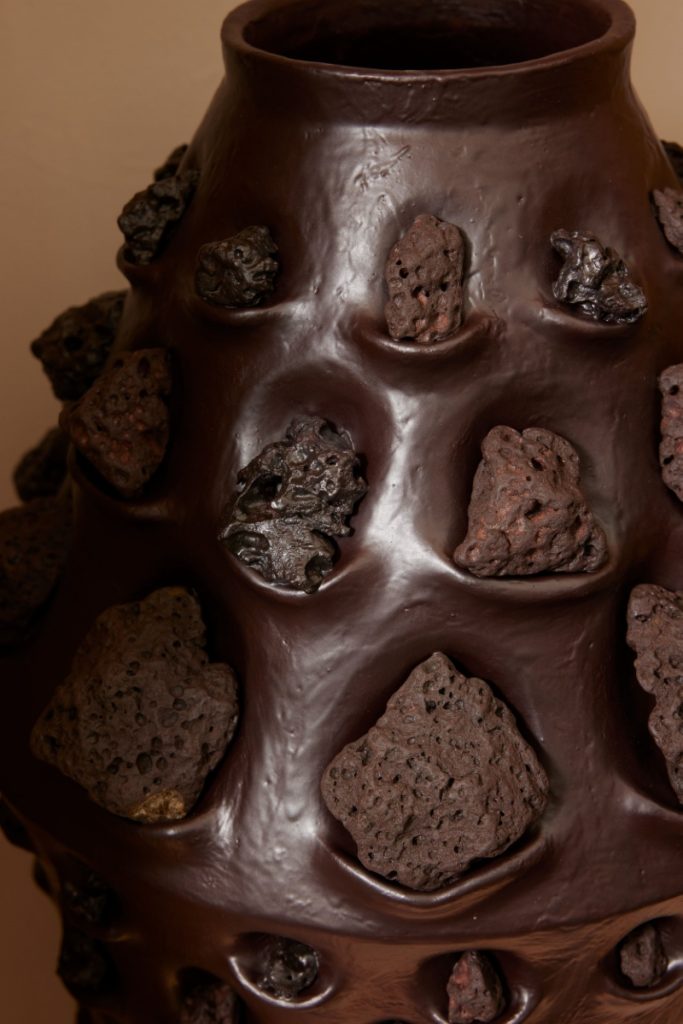
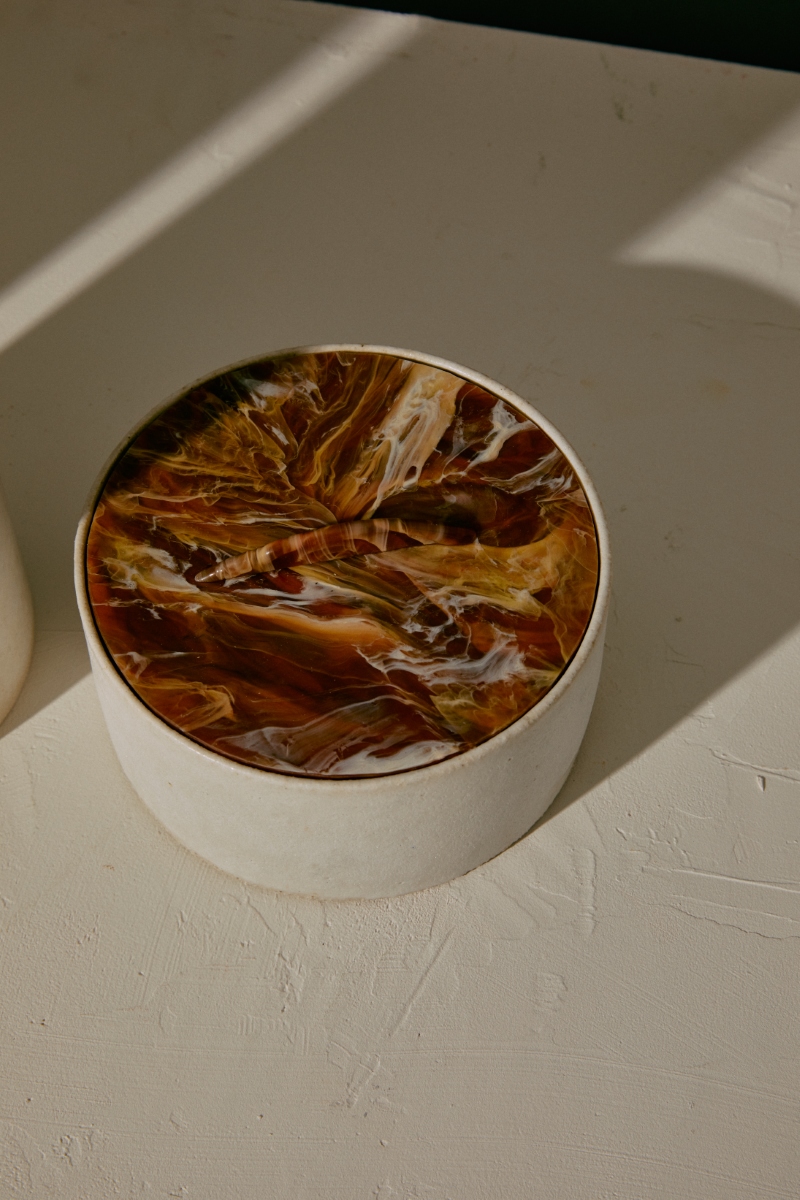
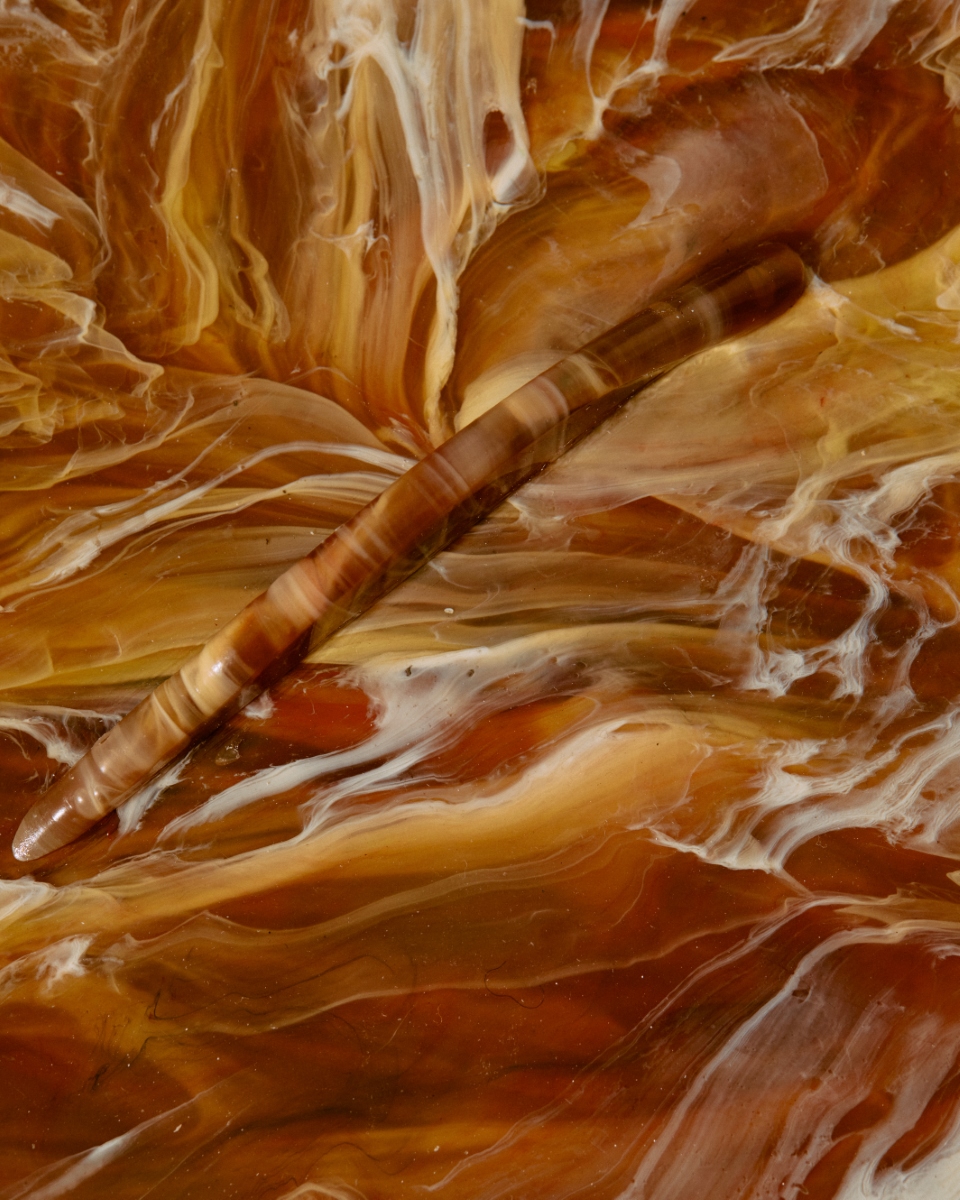
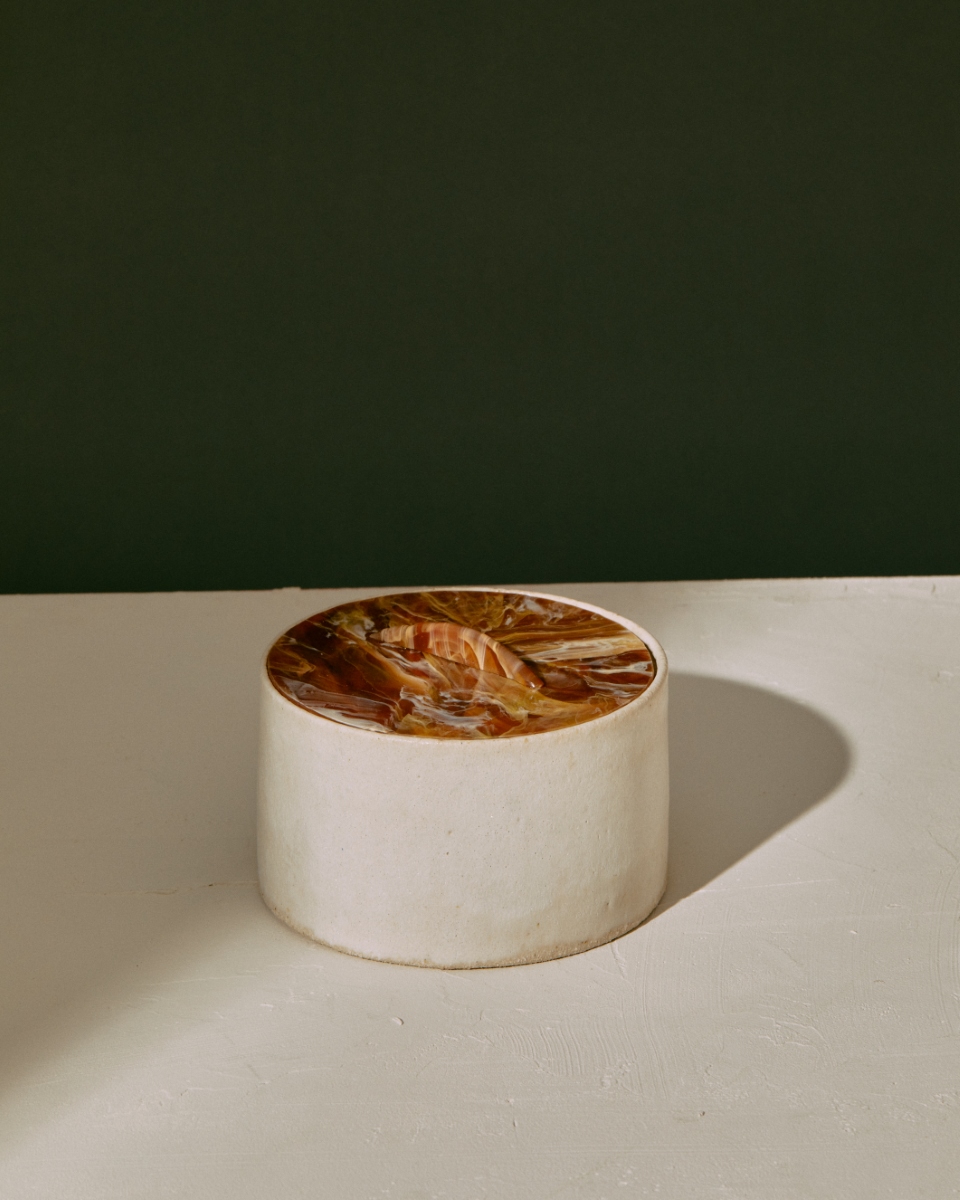
Ellis goes to great lengths to keep materials out of the landfill. Nothing goes to waste – even the plastic bags that clay comes in are washed and melded and turned into beautiful onyx-like lids for her ceramic containers. Her commitment to sustainability also extends to her tableware collection which incorporates recycled materials such as eggshells and glass.
Ellis has completed a number of artist residencies and her work has been exhibited in Paris and Milan. With several awards under her belt, she was a guest speaker at The Australian Ceramics Triennale in 2022. The artist is driven to bringing awareness to the impact of traditional industrial practices on our planet. She feels a sense of personal responsibility towards her adopted country – evident in the sentiment expressed on her website’s footnote:
I acknowledge the Wurundjeri Woi-wurrung people of the Kulin Nation, the traditional owners of the land on which I work and I also acknowledge the traditional owners of the lands across the world where materials and knowledge in my practice originate. I recognize their continuous connection to Country and I pay my respects to their Elders past and present.
Individual acknowledgements recognizing the country’s original inhabitants have become common practice in Australia. As a nation, Australia is starting to come to terms with its colonial history; appreciation of First Nations’ connection to country is becoming more widespread. With her training as an arts conservator, artist Georgia Harvey has insights into how cultural objects carry the stories and ideas of their makers and she recognizes her responsibility “to preserve cultural artifacts so as to learn from the past and better understand the present.” The self-taught maker has developed her own unique style, drawing from her experiences working with cultural collections, in particular antiquities as well as her earlier studies in painting.
Since discovering her love of ceramics, Harvey has built a flourishing practice in her backyard studio, where she says she makes ‘new discoveries every day.’ The artist’s remarkably varied yet cohesive solo show Lion-ish–also at Craft Victoria–is composed of twenty-three ceramic iterations of the lion as polysemous icon. Harvey is known for exhibitions that demonstrate a convergence of styles. Viewing the totality of Harvey’s idiosyncratic lion sculptures is like taking a kaleidoscopic tour of the ancient world seen through a modern lens.
The gallery describes her show as “a playful celebration of this diversity of perspectives and realities.” Harvey describes her pieces as ‘ancientesque’, animistic, and playful but her profound knowledge of cultural and historical context is evident throughout the exhibit. The artist acknowledges that her distinct, imperfect style walks the line between ‘not too cute and not too hideous but perhaps inhabiting a slightly unsettling space in between.’
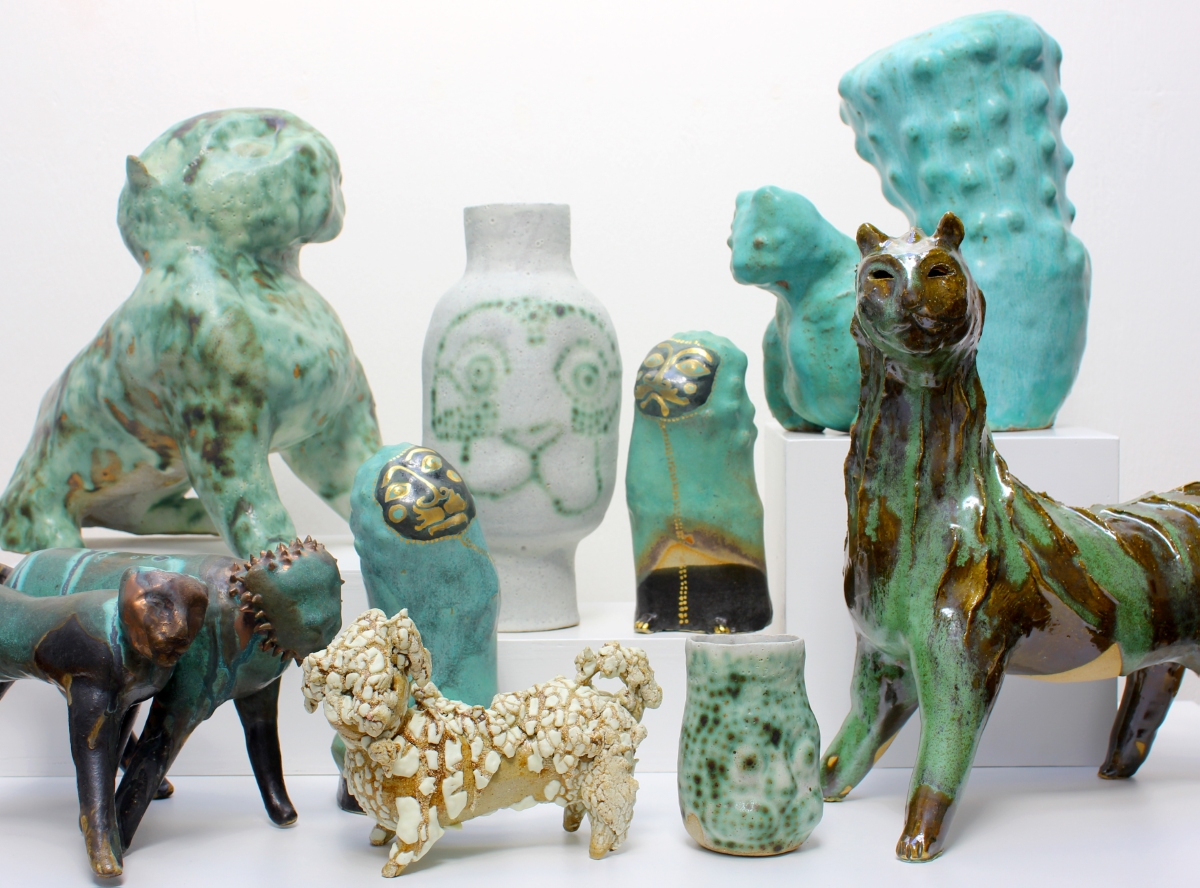
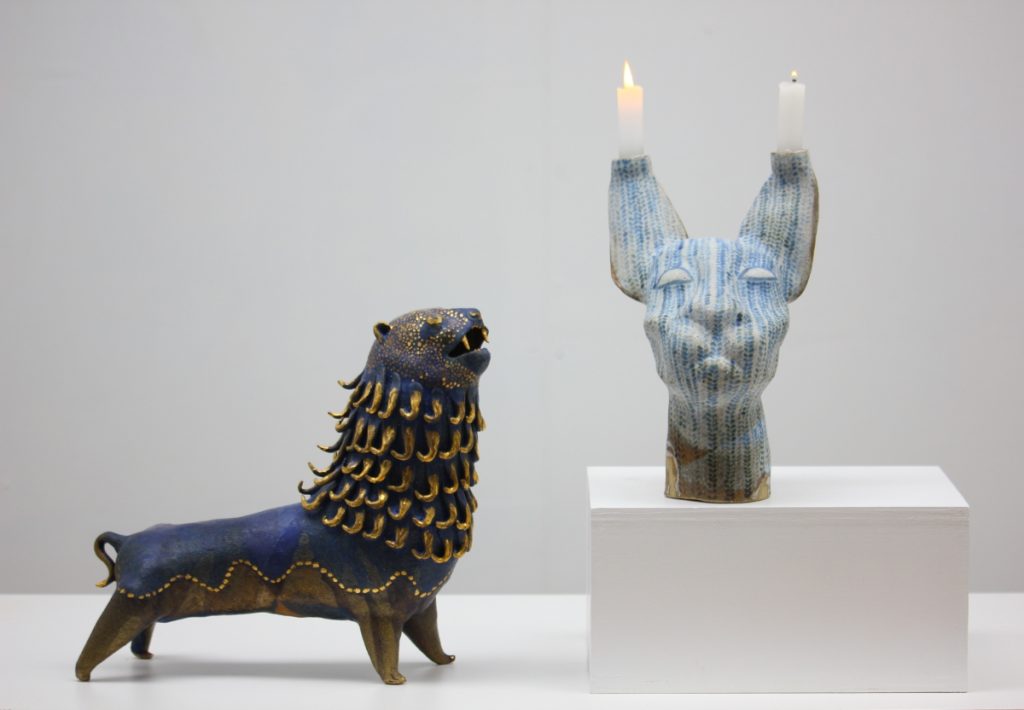
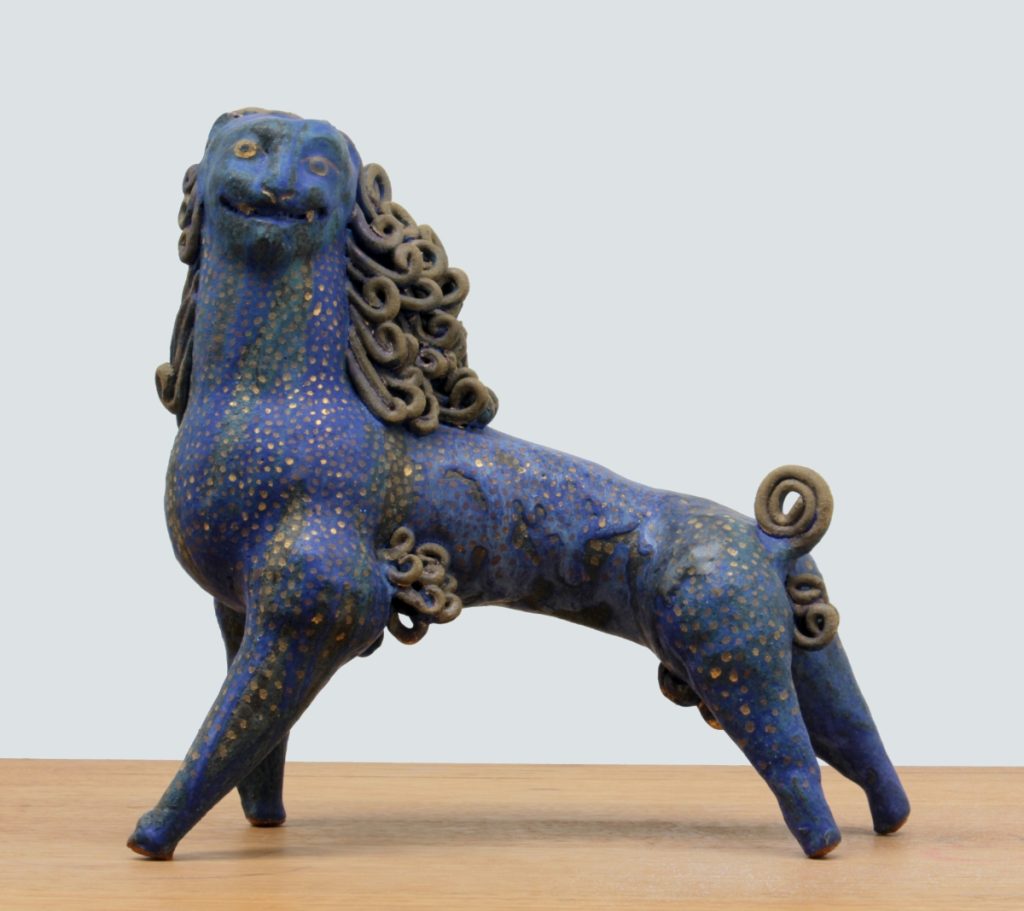
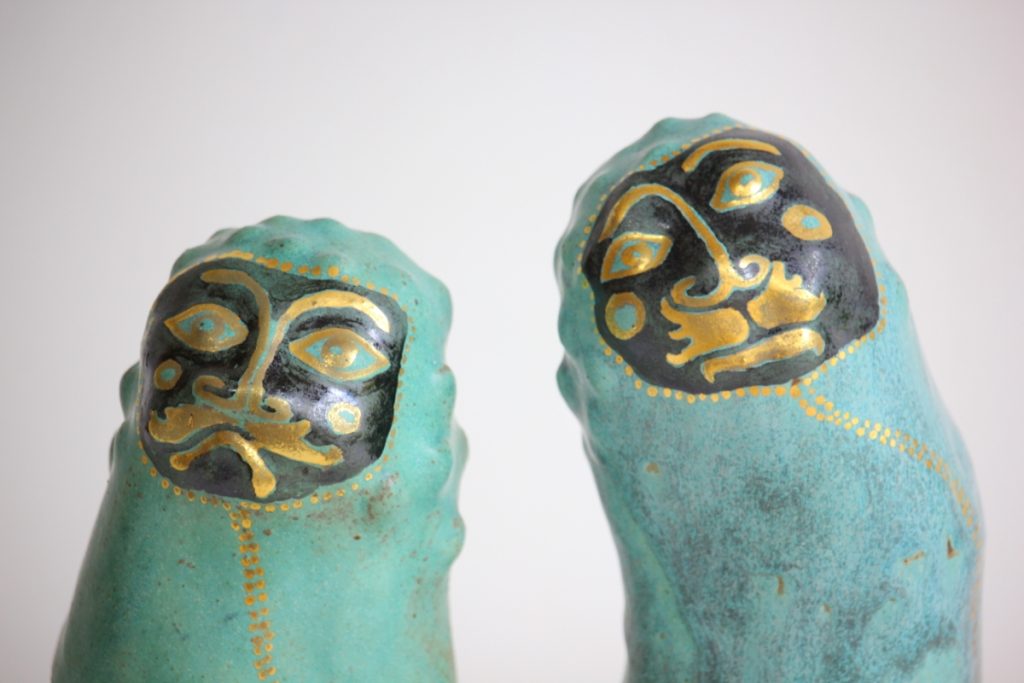
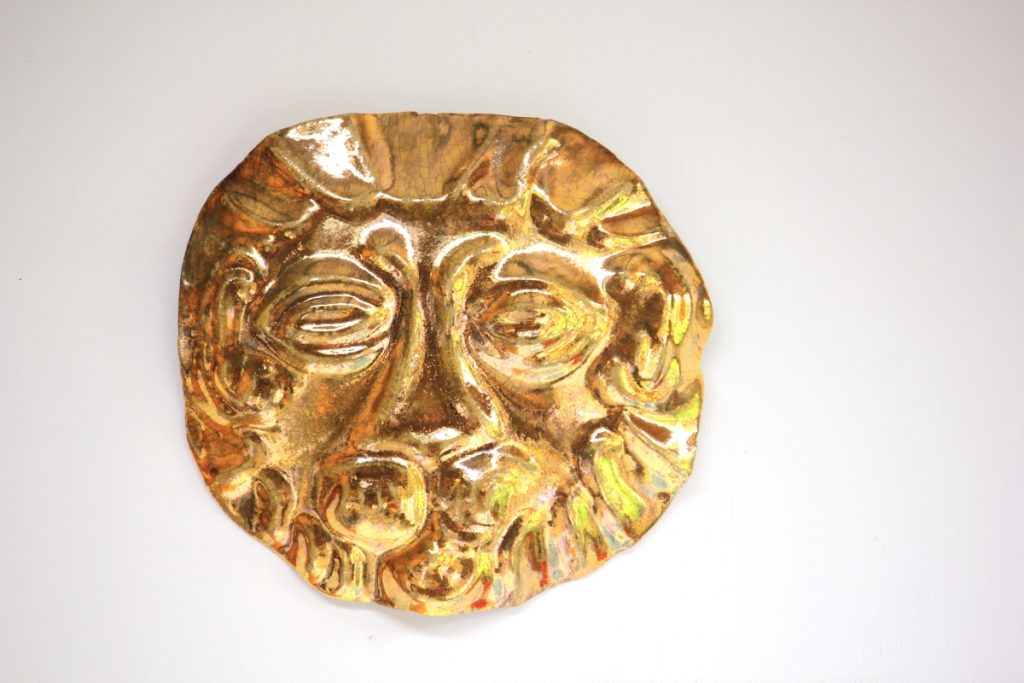
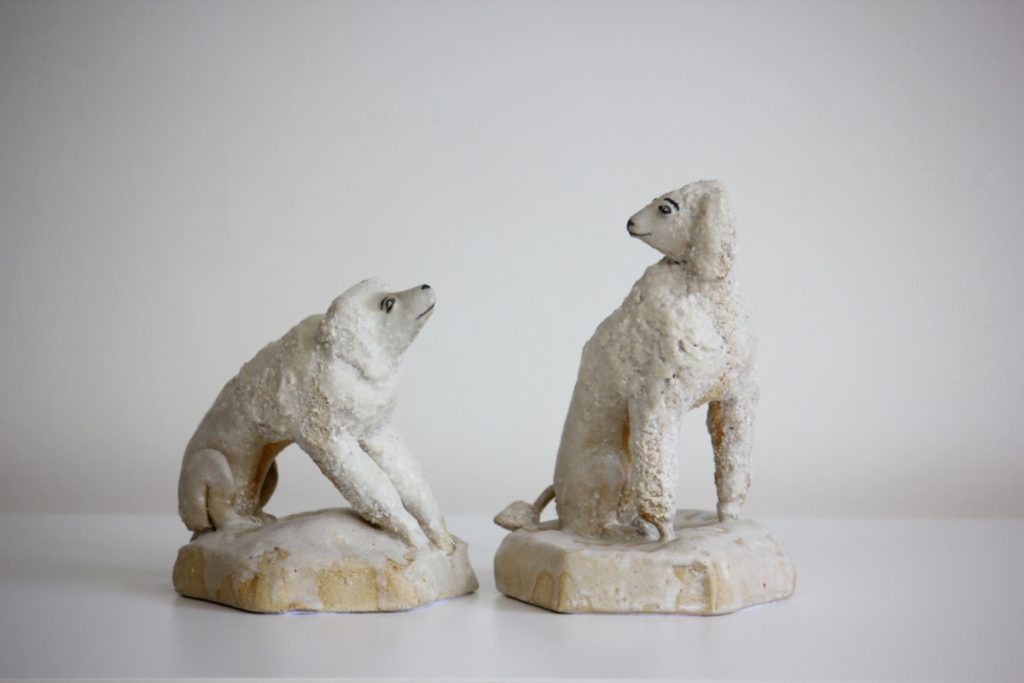
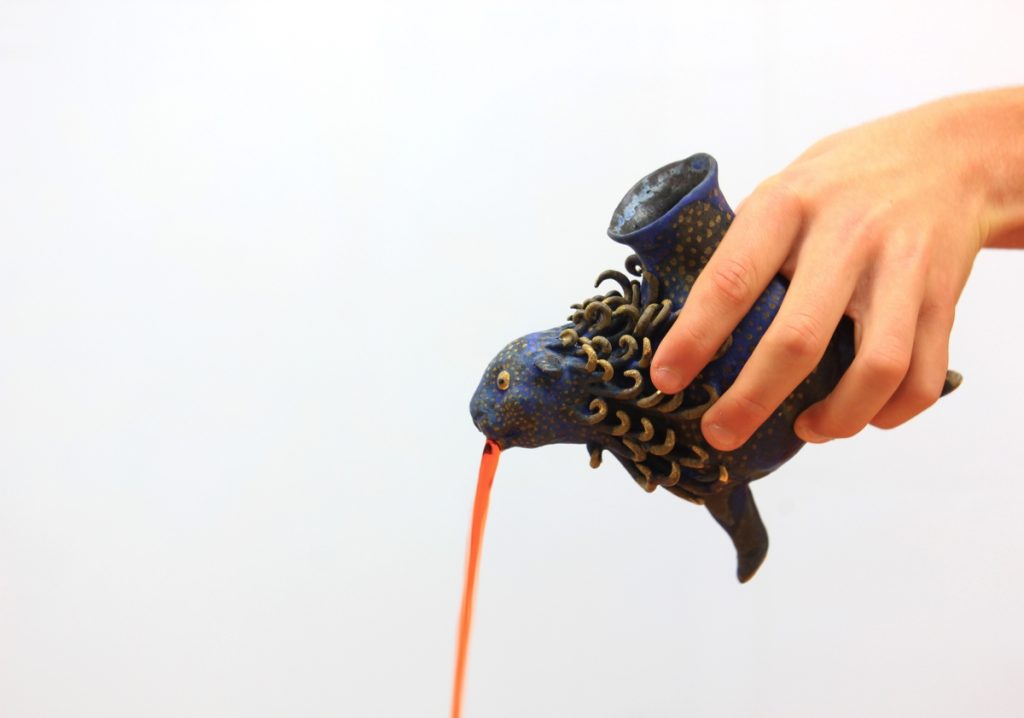
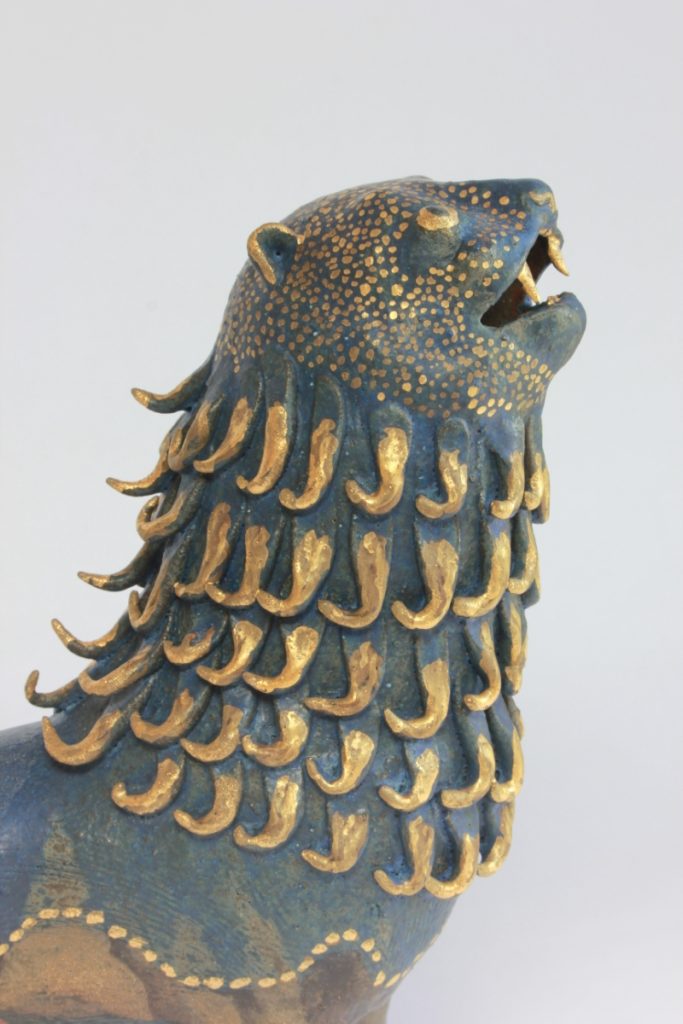
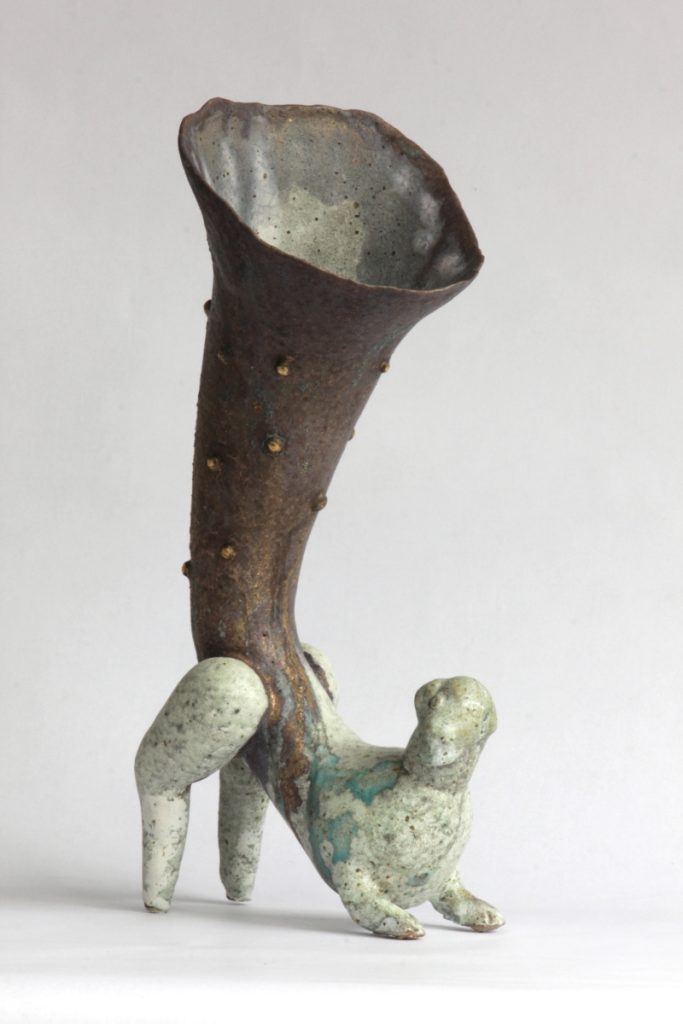
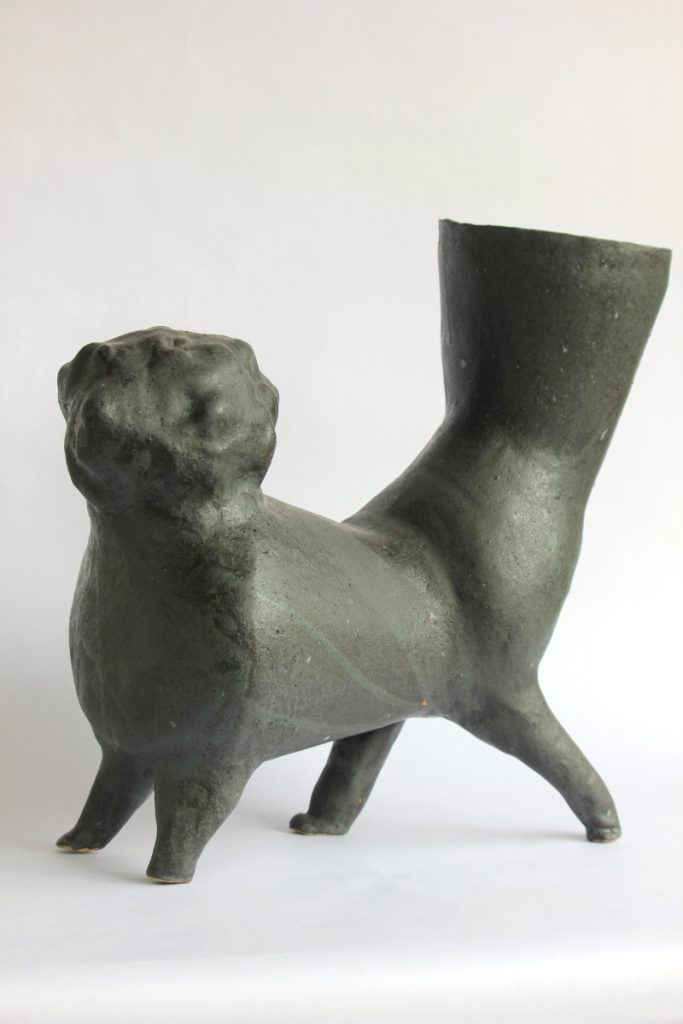
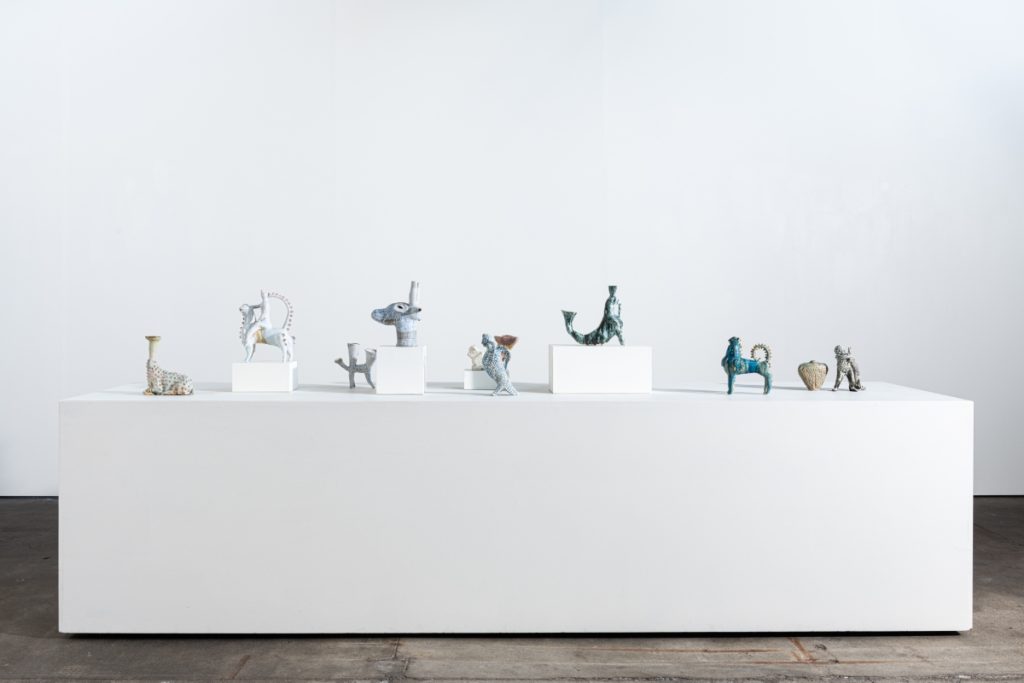
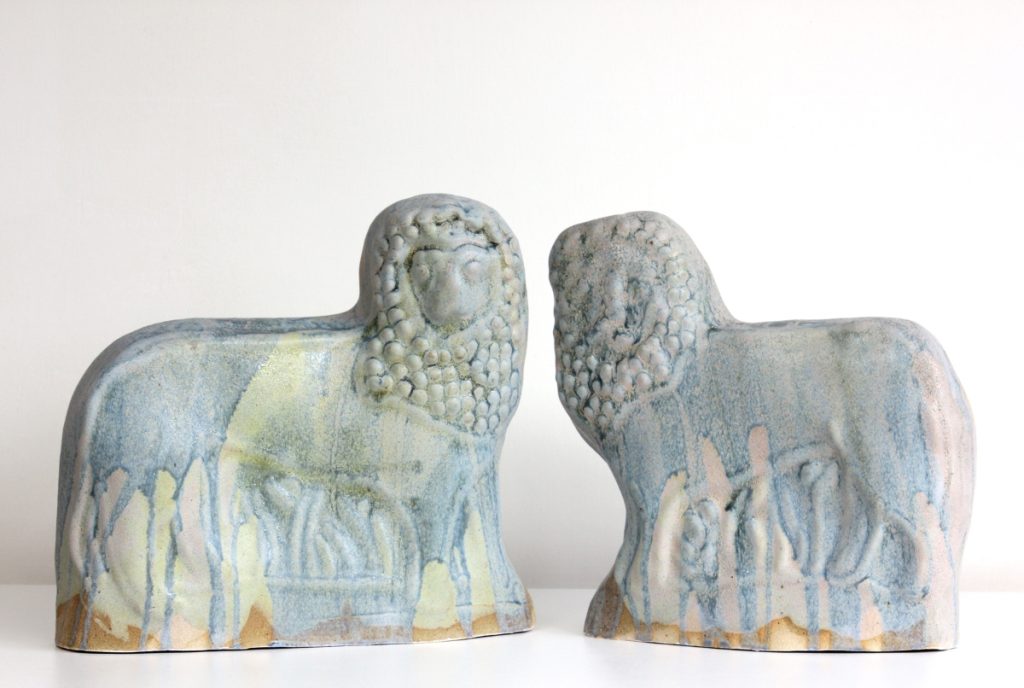
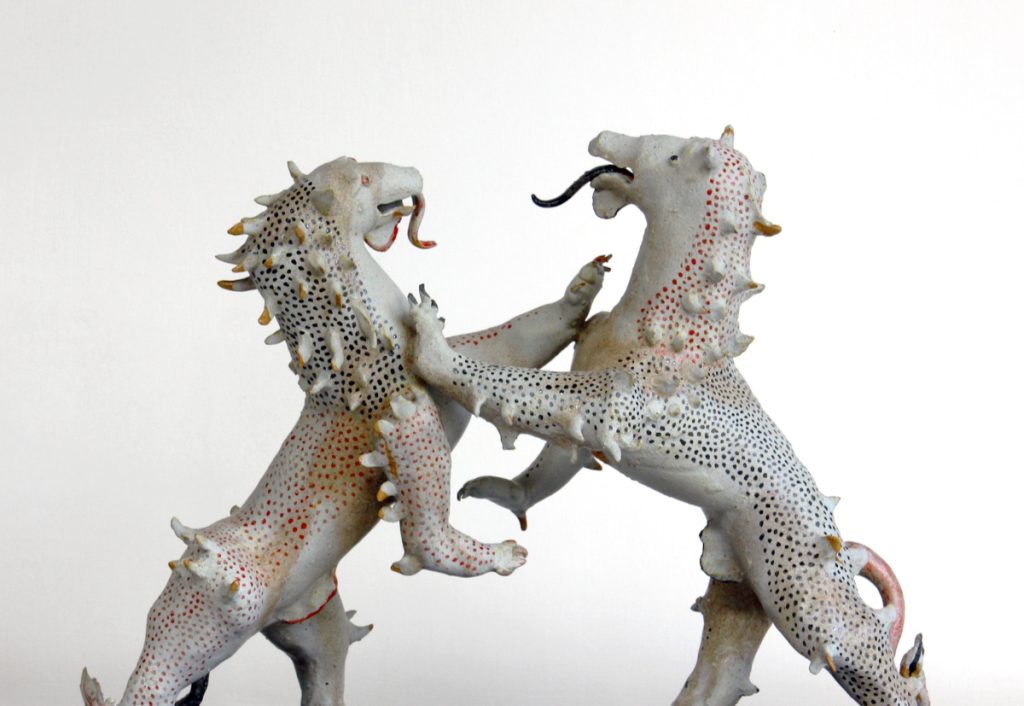
Harvey finds inspiration everywhere – medieval illuminations, archaic ceremonial vessels, sentinel statuary, heraldry, kitsch figurines. She is drawn to animal forms and honed in on the king of the jungle for her Lion-ish exhibit, fascinated by the way in which different cultures (some of which had never laid eyes on an actual lion) purloined this creature to represent often disparate symbolic significance. She references Plato’s Allegory of the Cave which questions the philosophical nature of Truth and its subjective interpretations.
Harvey is well-traveled and lived for several years in the UAE. Her lion series was inspired by multiple influences and while she plays with ideas of origin, she is conscious of poaching too literally from other cultures. Her sculptures materialize “through the prism of her hands,” each emerging as a unique character flavored with opaque cultural references and timeless beauty. During the creative process, Harvey allows herself to get lost, trusting the clay to lead her down the right path. “It’s all about the process for me,” says the artist. “I’m never too distraught when things don’t work out – I see it as an opportunity to make something else!” Harvey even imbues bottle forms with personality and believes that a successful result is one that breathes ‘a spark of life’ into her creations.
The collaborative ceramics exhibition by artists Kate Jones and Parker Lev Dupain at Oigall Projects was spread out over the gallery’s three rooms. Entitled Cubby, the exhibition centered around the concept of the container as a space that “may offer solace to one and unease to another…eliciting a sense of exploration and imagination.”
My first impression upon entering the primary gallery space housing Jones’ expressive, oversized forms was that of walking through the Australian ‘bush’, the term used to describe the Australian countryside. The hand built vertical forms, adorned with bold, painterly brushstrokes, were reminiscent of Australia’s iconic eucalyptus trees – the coloring, the rough texture, the sheer solidity of a stand of trees. There is a timelessness to Jones’ sculptural constructions, built to last a lifetime. A few of the forms were decorated with mythical imagery that evoked early Aboriginal bark paintings. Jones uses coil and slab techniques, liberally decorating her surfaces with stains, colored clays, oxides, terra sigilata and glazes, and has recently begun using staples to enhance and further draw attention to cracks.
As both the current President of The Australian Ceramics Association and Director of Australian Ceramics Triennale, Kate Jones is not only actively engaged with the Australian ceramic community but influential in forging its path and identity. In addition to her creative output, Jones engages in research, writing, curating, and teaching. She thinks deeply about all aspects of ceramics, probing the art of creation as intensely as delving into the underlying motivations behind collecting. Her articles for The Journal of Australian Ceramics provide insight into Jones’ work ethic and purpose. “I want art to stop time, to disrupt context. To take me somewhere else, or to bring me home. Art’s objects are messengers bringing us news from nowhere, missives from other ways of thinking or being. They have a capacity to convey meaning which language cannot quite grasp, and thus they expand our range of expression. As potters, we are fortunate to work in a field where the possibilities for our objects to touch others are so direct and so expansive.”
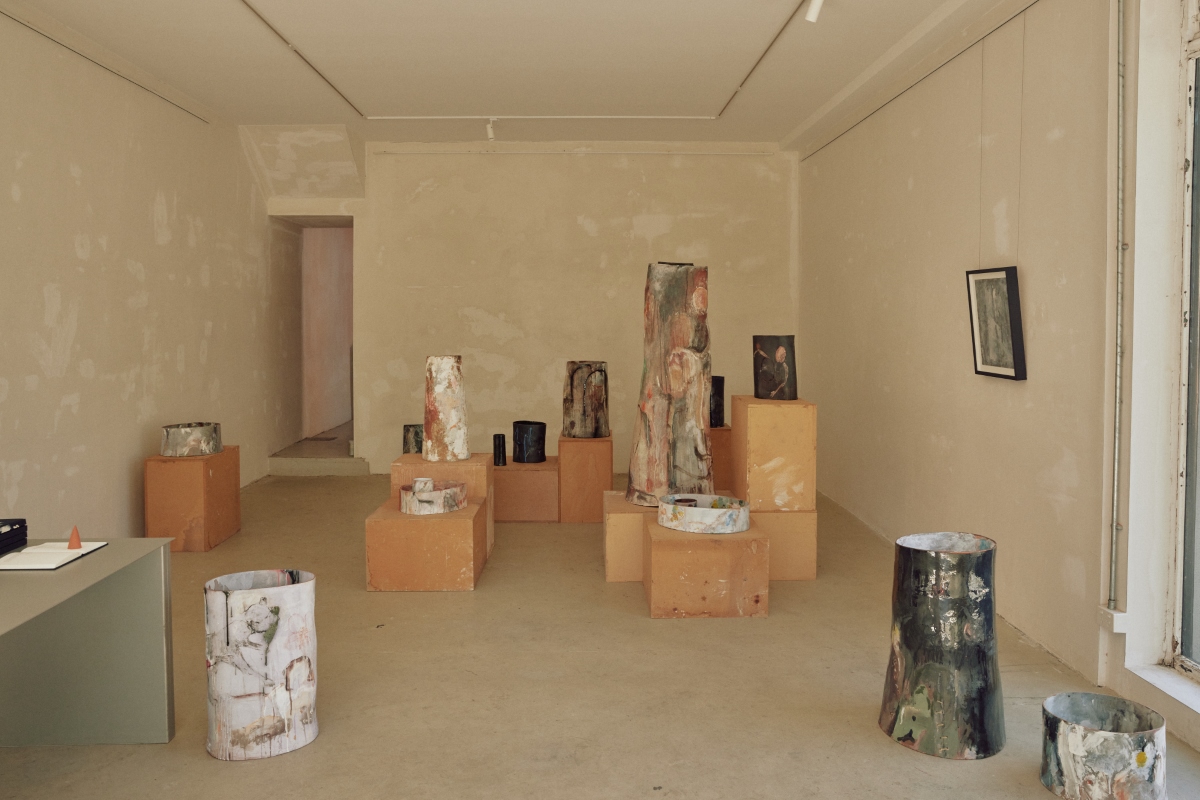
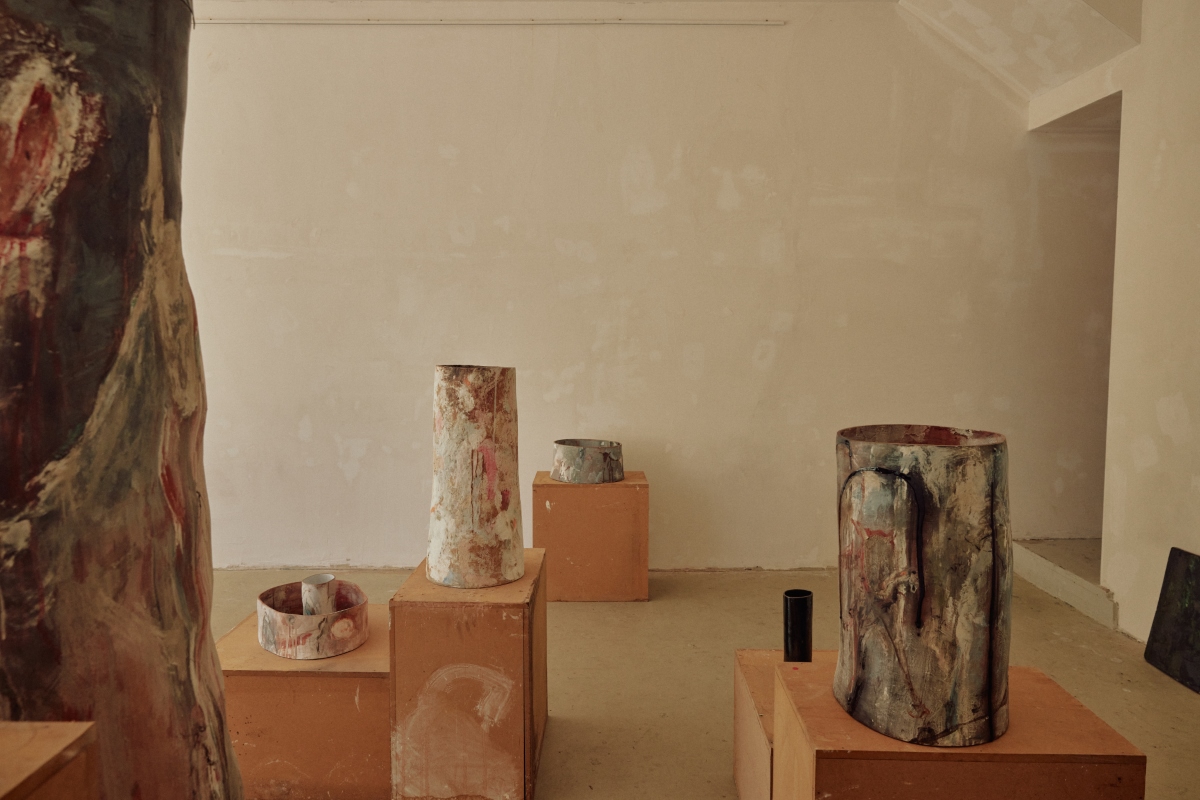

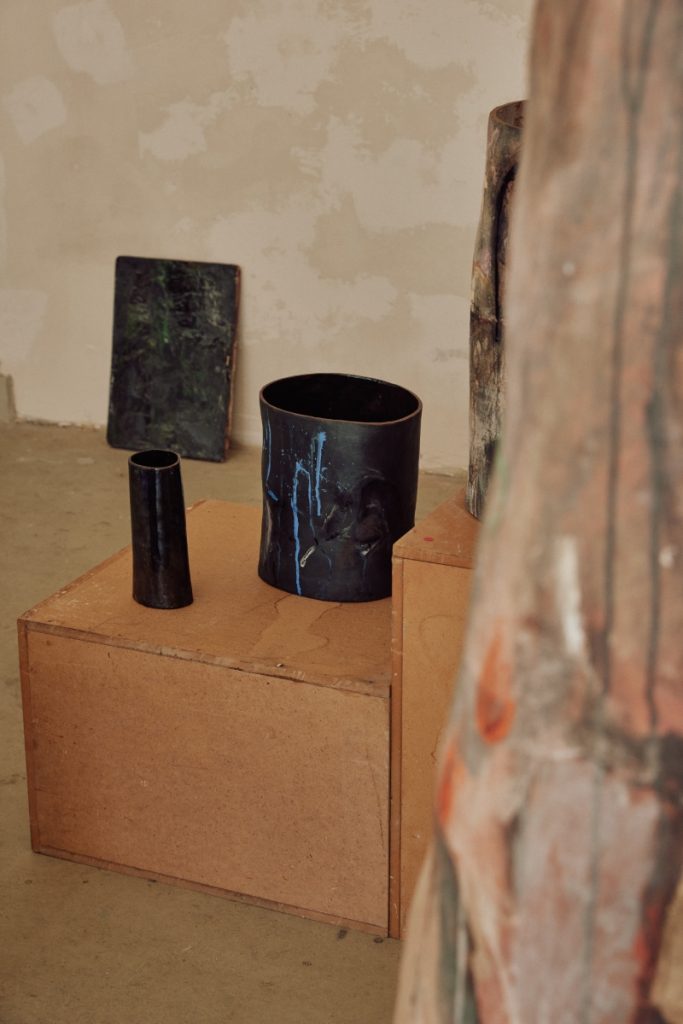
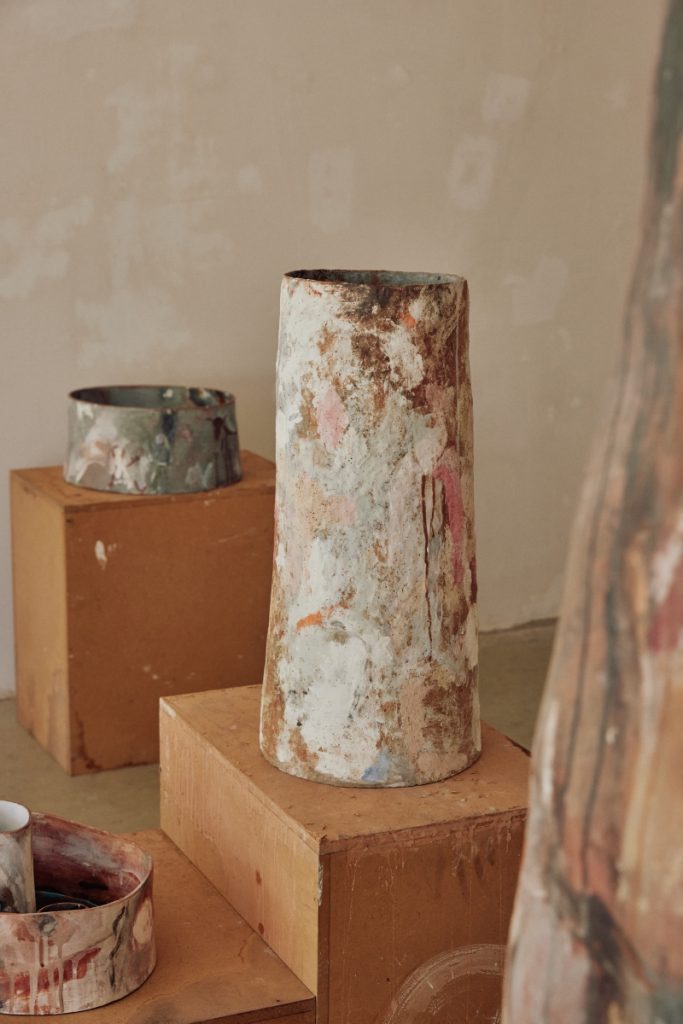
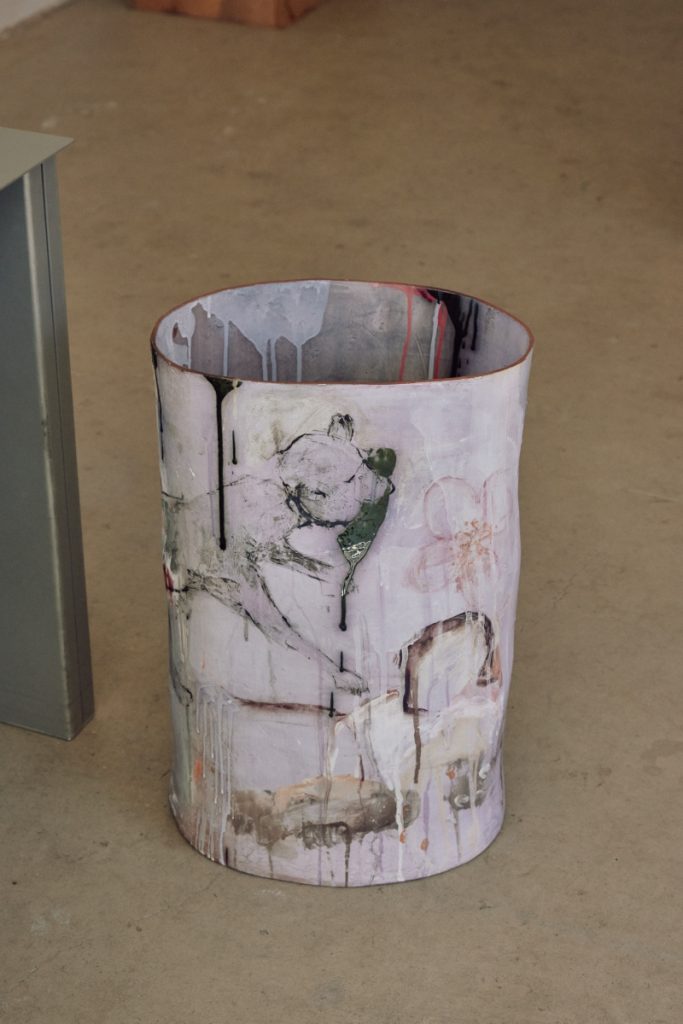
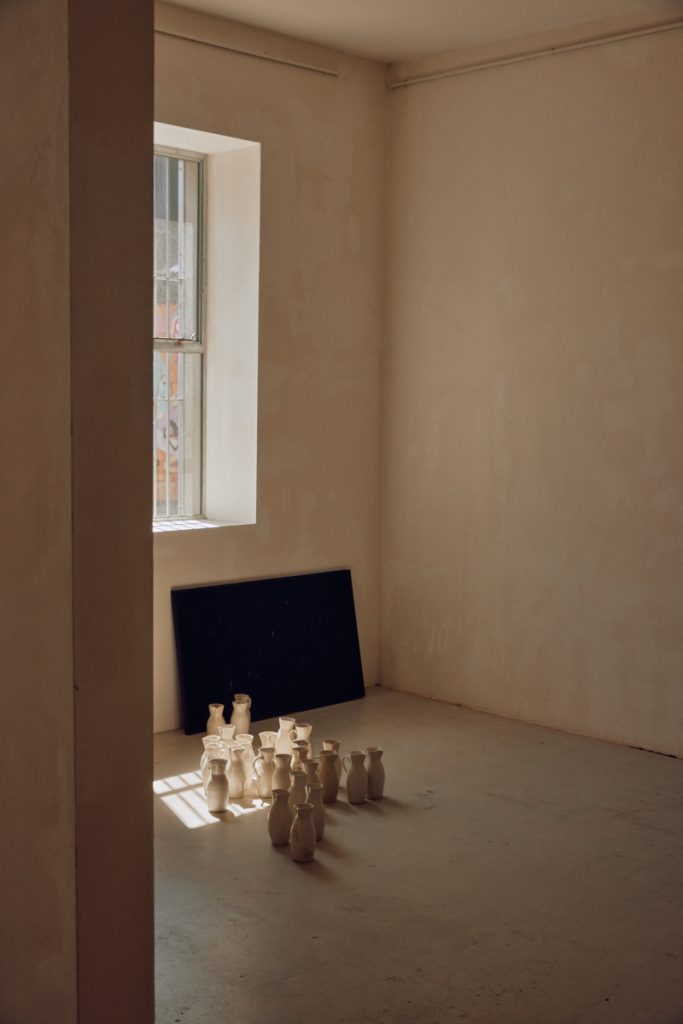

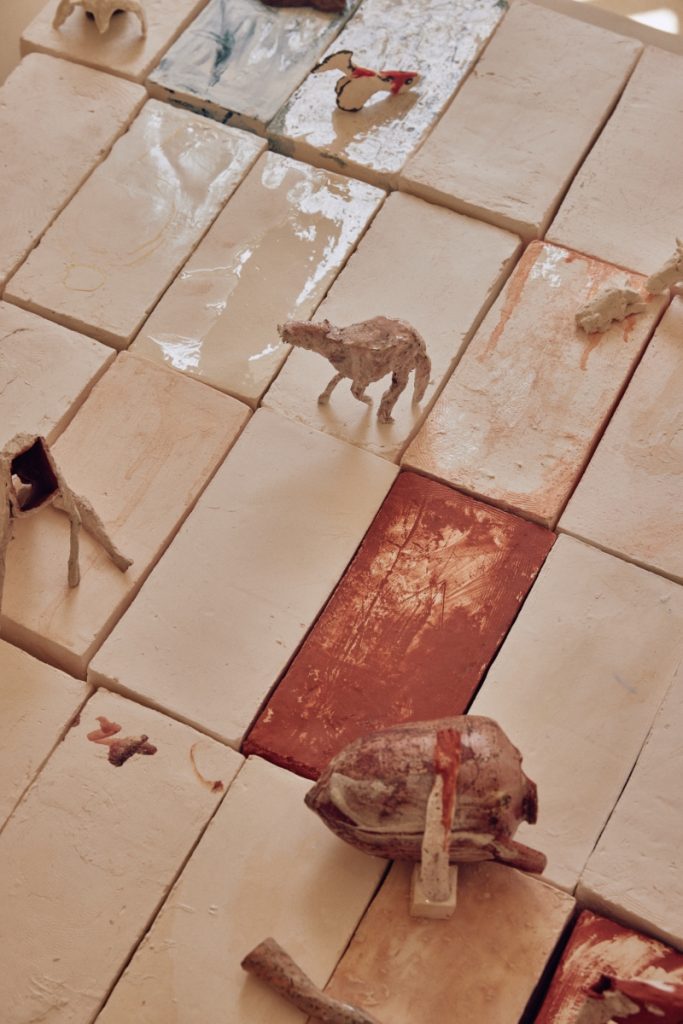
The multi-media installation devised by Jones together with her studio partner, visual artist Parker Lev Dupain, included an olfactory element in the form of a scent designed specifically for the exhibition. Parker’s ceramic oeuvre includes thrown tableware that draws on the history of ceramics in domestic contexts and experimental sculptural forms that push the limits of the material.
The third gallery space at Oigall Projects presented a collaborative installation by Jones and Dupain built upon a bed of handmade porcelain bricks of varying shapes and sizes. Upon this bleached expanse, the artists placed random figurines and small ceramic knickknacks at sparse intervals. The overall impression was once again evocative of Australia’s drought-parched interior, a feeling further enhanced by various emaciated bestial figures.
The three exhibitions revealed a refreshing Australian flavor that addressed global issues while demonstrating cutting edge practice and experimentation in the field of contemporary ceramics. Each artist expressed their global and personal concerns through careful consideration for both materiality and concept. Though the works diverged widely in technique and aesthetics, the narrative thread that defined all three shows was the dominant role that political and social principles are playing in contemporary ceramics. Only by confronting burning issues can we bring people into the debate.
Lilianne Milgrom is an artist, ceramicist, freelance writer and published author. She travels widely and loves discovering new artists. You can see her artwork on www.liliannemilgrom.com and her writings on www.liliannemilgromauthor.com. You can also find her on Instagram @liliannemilgrom
Captions
- image 1. MOTHEROCK, Claire Ellis, 2023, sink sludge, recycled glass, rock by-products, photography by Lillie Thompson
- image 2. O Vessel SLATE, Claire Ellis, 2023, sink sludge, recycled glass, slate by-products, 18x18x7cm, photography by Lillie Thompson
- image 3. ‘Climate crisis costing $16m an hour in extreme weather damage, study estimates’, Claire Ellis, 2023, recycled earthenware and second life basalt, 61 x 30cm, photography by Henry Trumble courtesy of Craft Victoria
- image 4. ‘Australian fossil fuel subsidies costing taxpayers $65 billion a year: IMF’, Claire Ellis, 2023, recycled earthenware and second life basalt, 66 x 26cm, photography by Henry Trumble courtesy of Craft Victoria
- image 5. ‘Australia needs climate trigger laws, conservation groups say after failed challenge to coalmines’, Claire Ellis, 2023, recycled earthenware and second life basalt, 63 x 35cm, photography by Henry Trumble courtesy of Craft Victoria
- image 6. Triple Cooked, Claire Ellis, 2023, recycled earthenware and second life basalt, photography by Henry Trumble courtesy of Craft Victoria
- image 7. ‘Climate crisis costing $16m an hour in extreme weather damage, study estimates’, Claire Ellis, 2023, recycled earthenware and second life basalt, 61 x 30cm, photography by Henry Trumble courtesy of Craft Victoria
- image 8. Solace n15, Claire Ellis, 2022, reclaim stoneware, recycled glass and clay bags, 10 x 17cm, photography by Annika Kafcaloudis
- image 9. Recycled plastic clay bags detail, Claire Ellis, 2022, photography by Annika Kafcaloudis
- image 10. Solace n15, Claire Ellis, 2022, reclaim stoneware, recycled glass and clay bags, 10 x 17cm, photography by Annika Kafcaloudis


